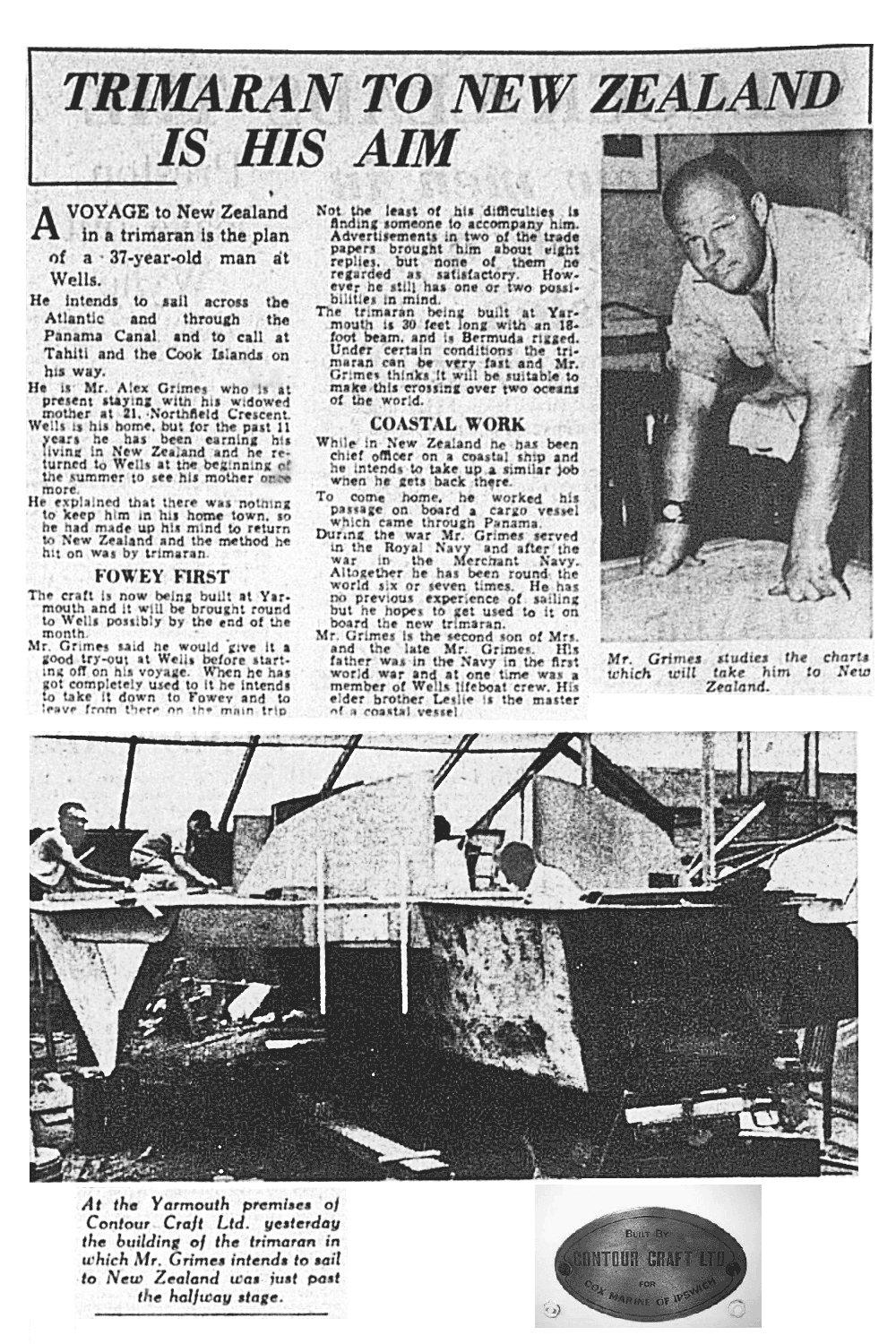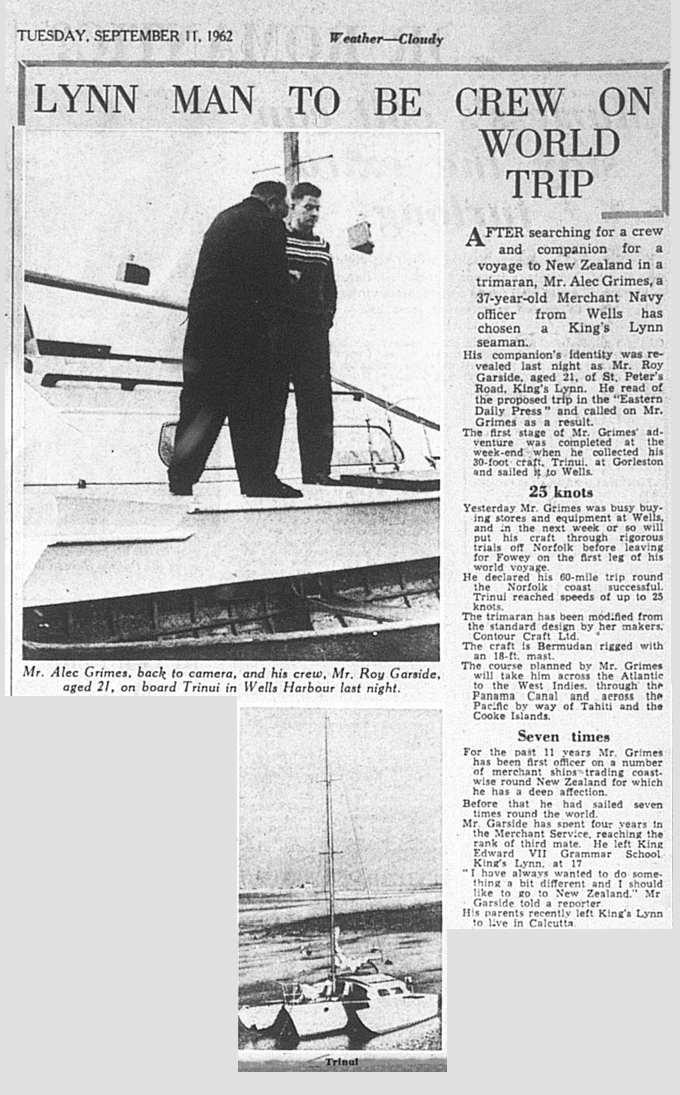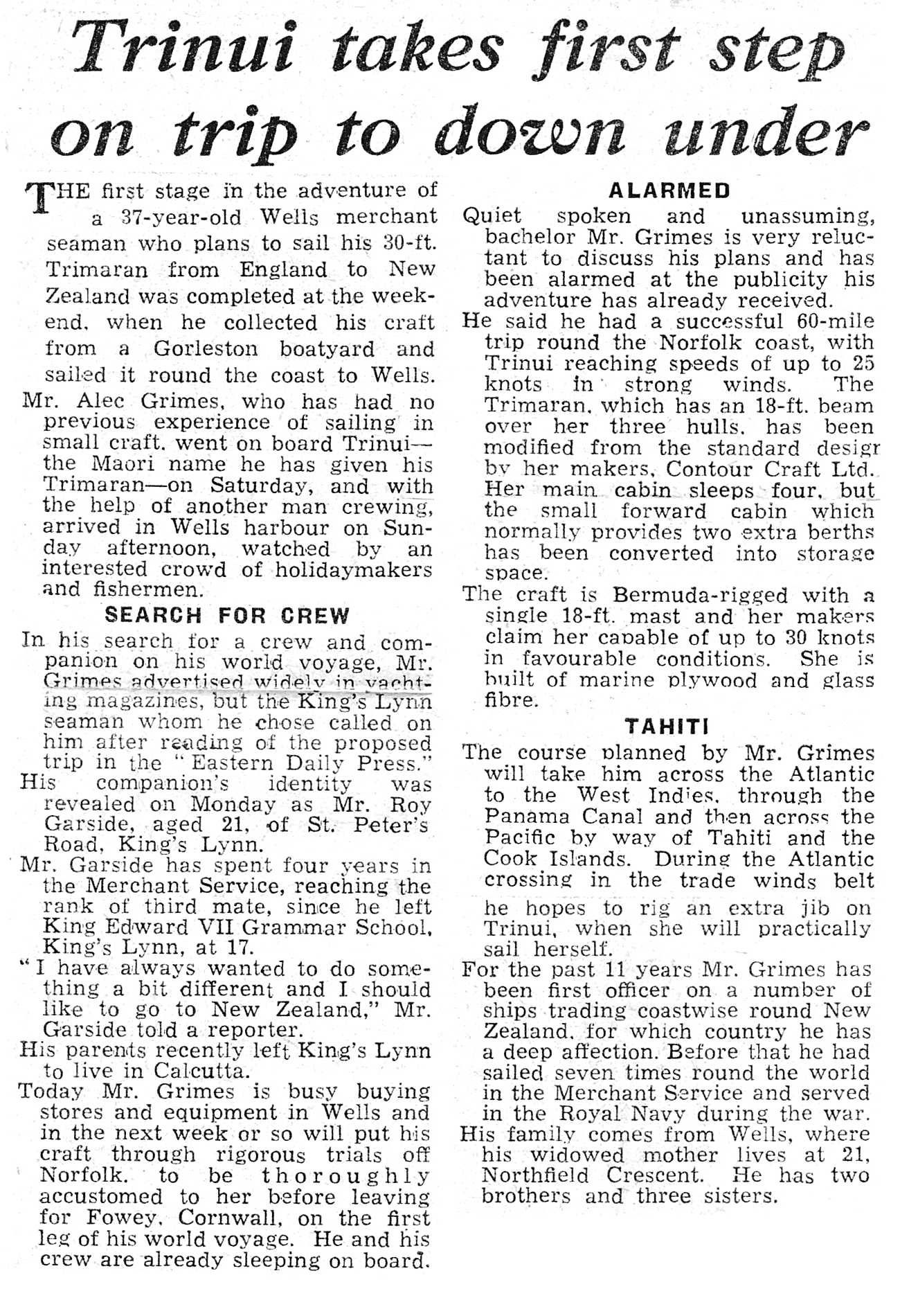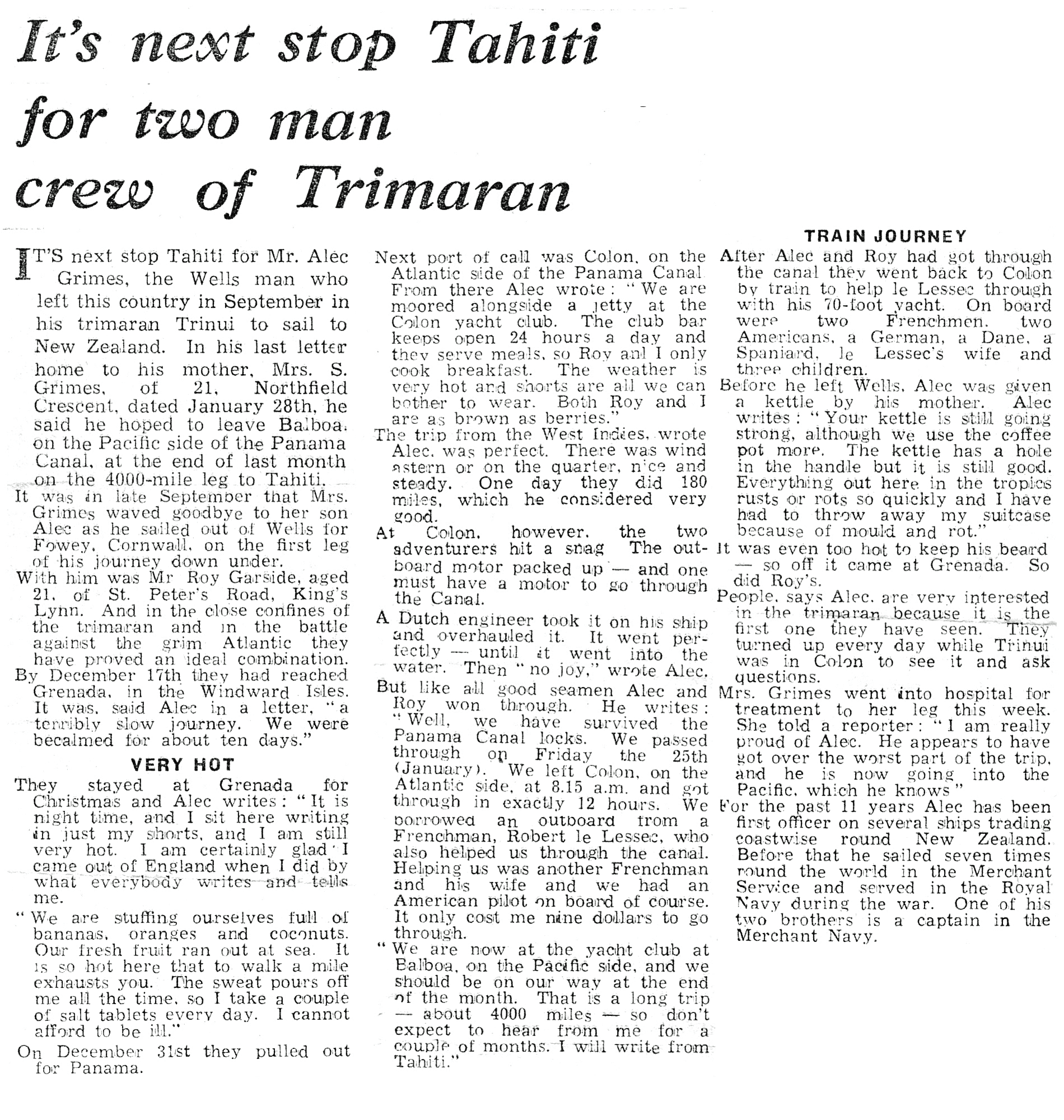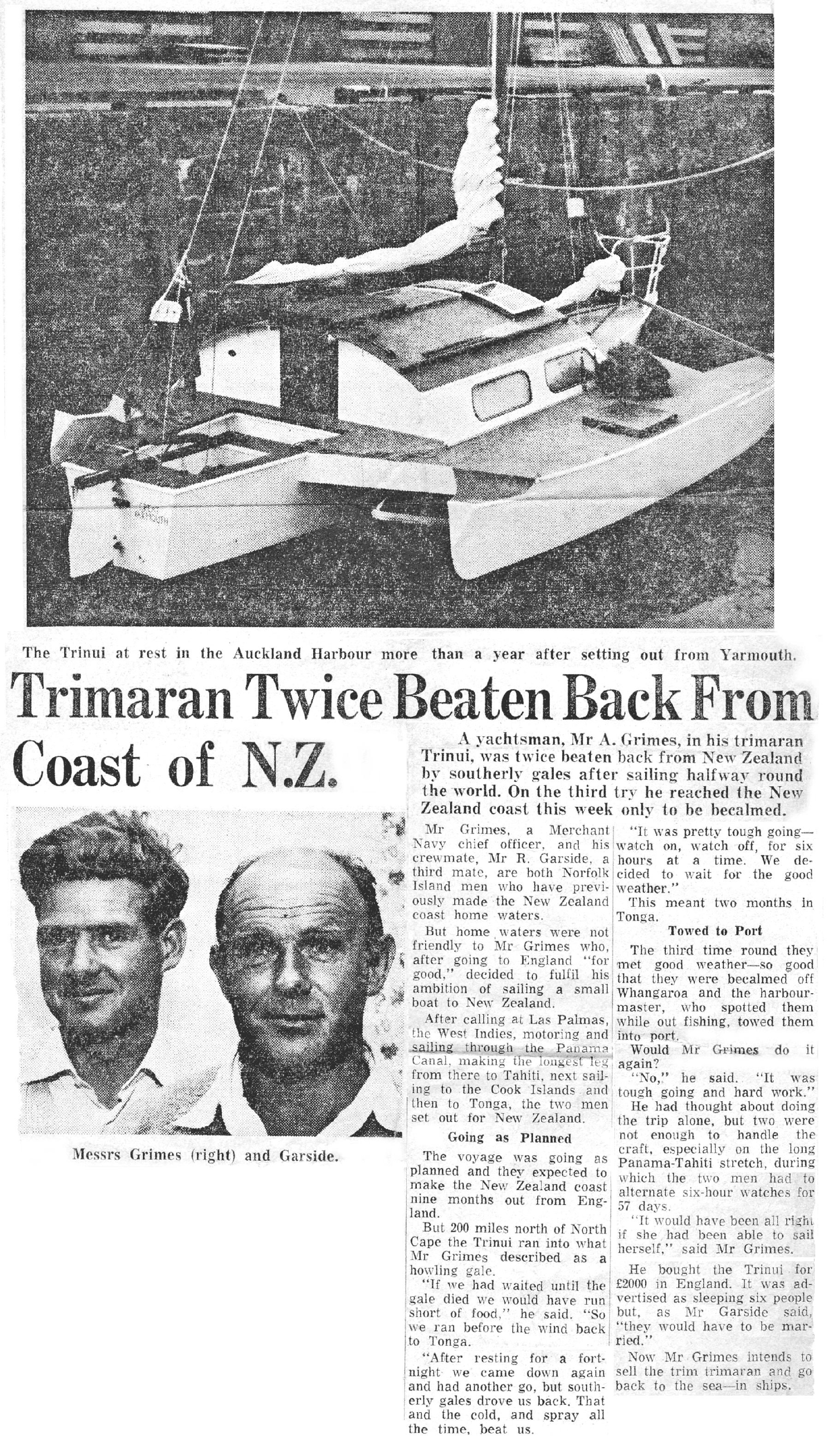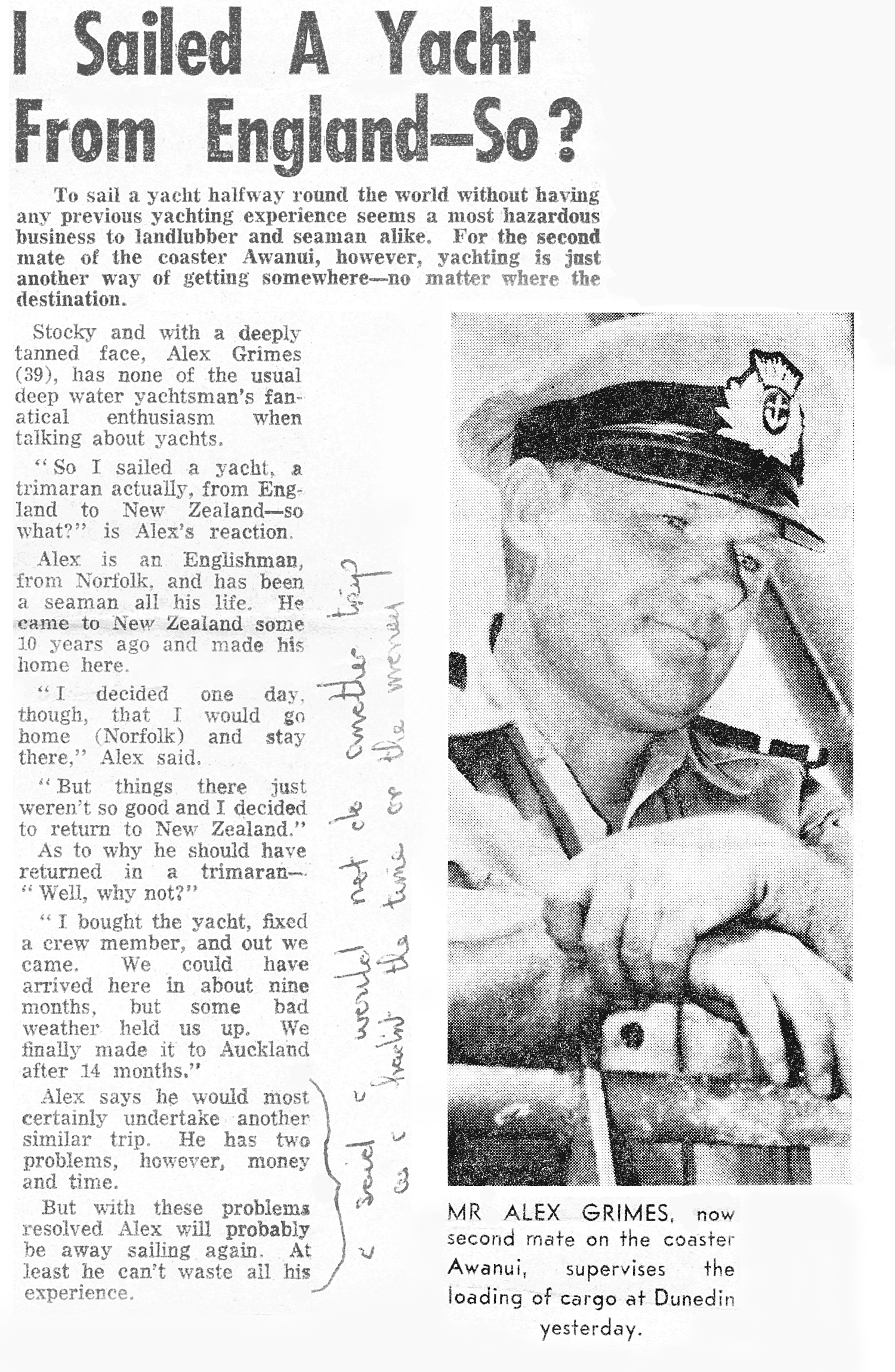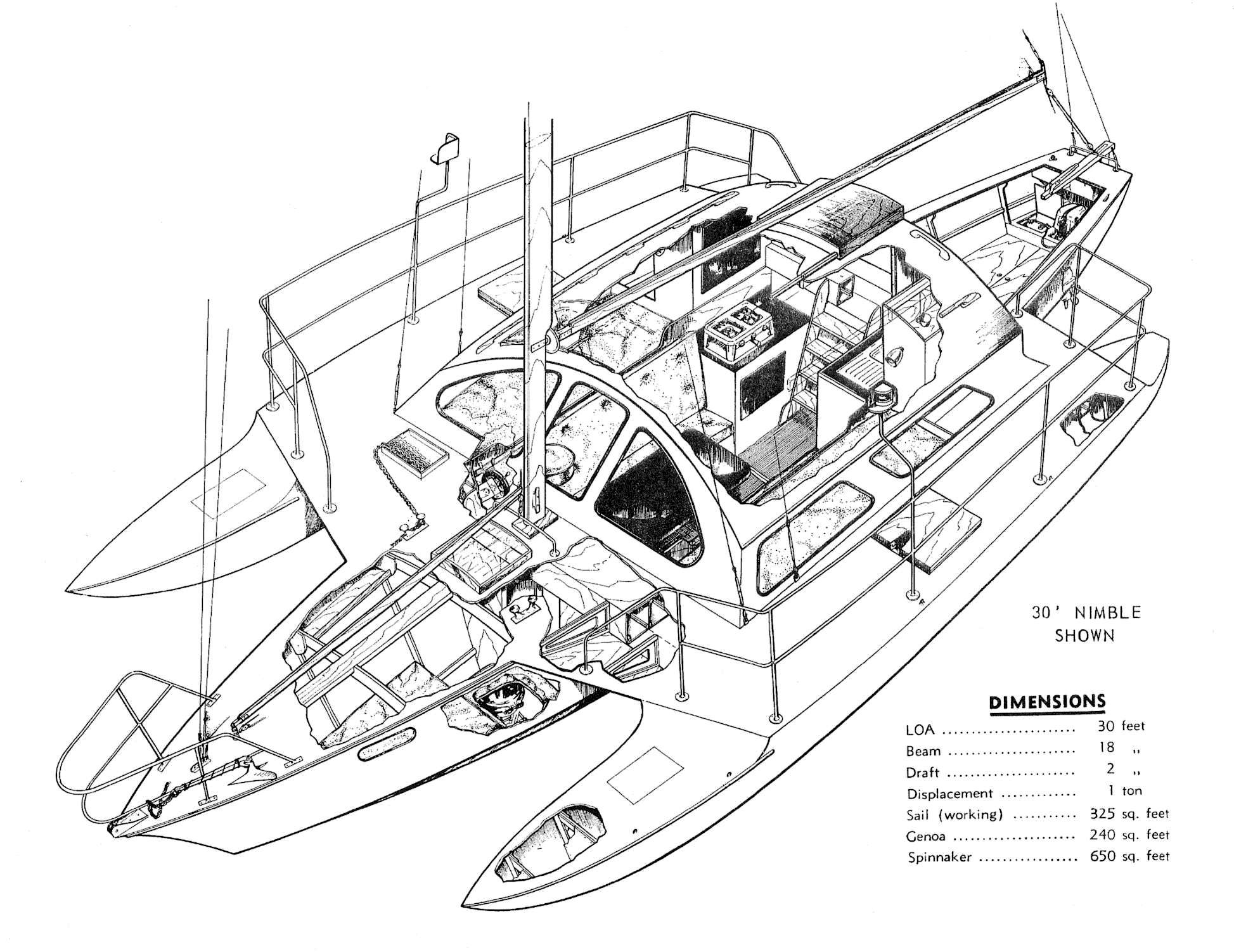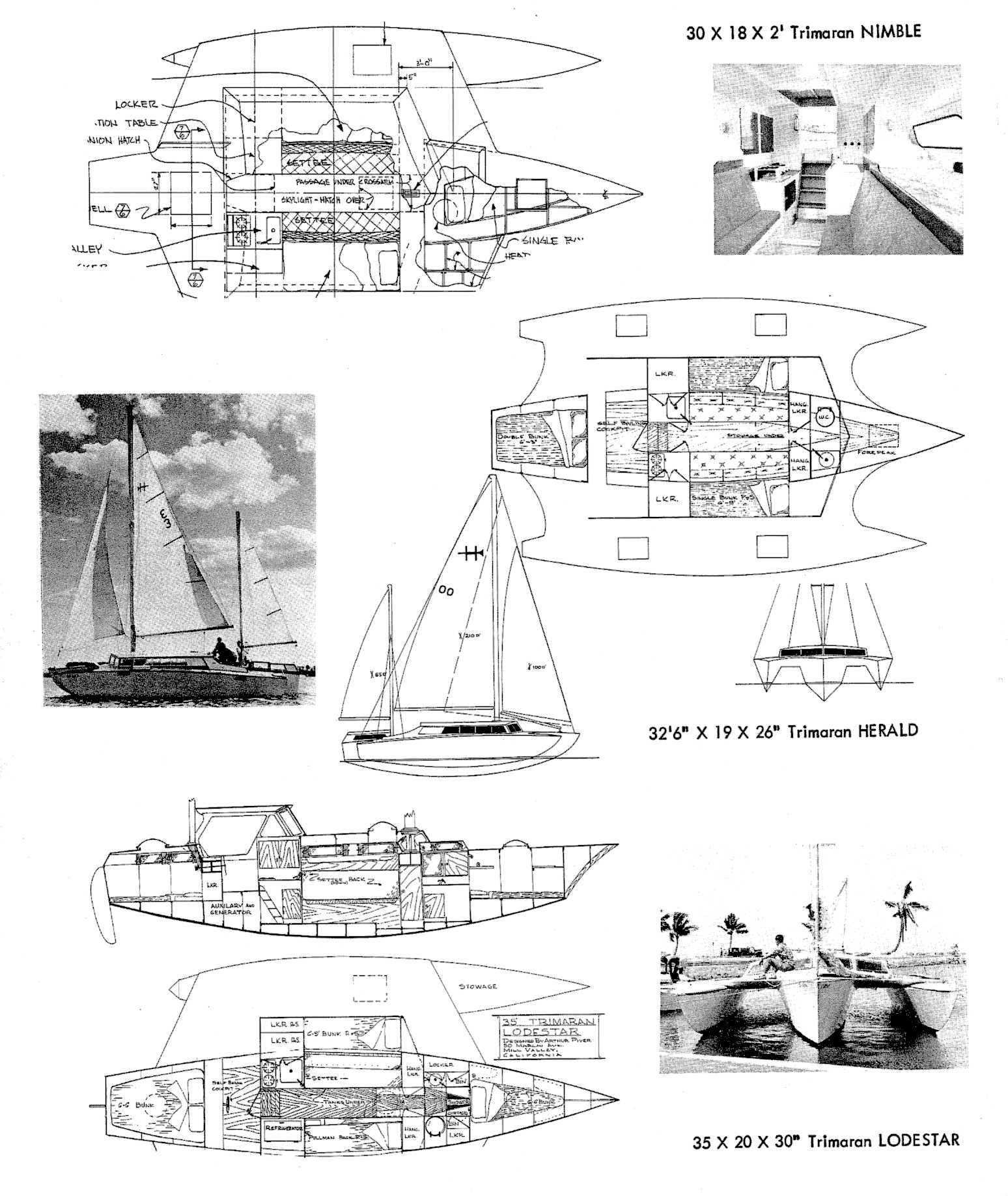Alex Grimes
Makes first ever voyage
from England to New Zealand
in 30ft trimaran yacht in 1962/63

Alex Grimes made the 14 month voyage from his home town of Wells Next the Sea, Norfolk sailing in a 30 foot trimaran named 'Trinui'.
This record voyage for a craft of this kind was documented by D.H. Clarke in his book 'Trimaran Development' as the first trimaran across two oceans, and the first multihull across the Pacific after early Maori migrations.
He set sail 21st September 1962 and arrived in Auckland, New Zealand on 14th December 1963, as quoted in the press at the time,
"... a splendid feat to sail a 30-foot trimaran 11,000 miles across the Atlantic, through Panama, across the Pacific, at one stage several weeks out of touch with the rest of the world, to Auckland in New Zealand ..."
The yacht was built in Norfolk by Contour Craft of Gorleston (subsequently Cox Marine, Ipswich) following Arthur Piver's Pi-Craft plans for the Nimble trimaran. Essentially the craft was built of plywood with an external fibreglass coating to hulls and wings.
Eastern Daily Press editorial comment
15th December 1963
Announcement of the arrival in New Zealand.
"The landlubber can scarcely conceive what it has meant in terms of courage, faith and resourcefulness facing the oceanic vastnesses ..."

Copyright Eastern Daily Press (note: print layout modified for web page)
There appears to be one particular inaccuracy though: it is more like a total sailing distance of 15,000 miles (13,000 nautical miles), not 11,000 miles (9,500 nautical miles).
To follow up the reference to Frank Dye of Watton and sailing his cockleshell of a dinghy to Iceland, click here.

Press photos
These are the press photos taken by the EDP newspaper at the time of departure from Wells
All press photos copyright Eastern Daily Press
 Alex at the home of his mother (21 Northfield Crescent, Wells) plotting courses to NZ. The chart is for the Canary Islands, to pick up the north east trade winds.
Alex at the home of his mother (21 Northfield Crescent, Wells) plotting courses to NZ. The chart is for the Canary Islands, to pick up the north east trade winds.
I think the radio in the background was a Grundig Yacht Boy shortwave set. It was the sole communication equipment taken on board, capable only of receiving transmissions.
Partly visible on the wall is a photo of his elder brother, Leslie, my father, who also became a Master Mariner in the Merchant Navy.
 Trinui at anchor in the harbour at Wells.
Trinui at anchor in the harbour at Wells.
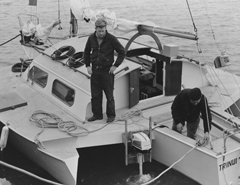 Shipmate Roy Garside and Alex checking out the outboard motor.
Shipmate Roy Garside and Alex checking out the outboard motor.
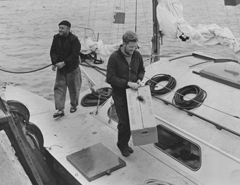 Alex and Roy loading stores prior to departure.
Alex and Roy loading stores prior to departure.
 Trinui in 'The Run' out of Wells bound for New Zealand.
Trinui in 'The Run' out of Wells bound for New Zealand.
 Trinui finally off under sail!
Trinui finally off under sail!

Some of our own family photos
We took these when I went with some of my family to Wells from Yorkshire in September 1962 to wish my uncle Alex a safe voyage.
The quality is not so good as they were taken with a miniature 35mm film camera.
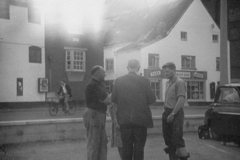 Alex and Roy on Wells quayside discussing voyage and possible press coverage with my great uncle Frank Barrett and his wife Nora. Both Alex and Roy were against any publicity for the voyage, other than coverage in the local newspaper.
Alex and Roy on Wells quayside discussing voyage and possible press coverage with my great uncle Frank Barrett and his wife Nora. Both Alex and Roy were against any publicity for the voyage, other than coverage in the local newspaper.
 Trinui at low tide moorings at Wells harbour. Here are Alex, my great uncle Frank, Roy, Frank's wife Nora, and their dog making an inspection.
Trinui at low tide moorings at Wells harbour. Here are Alex, my great uncle Frank, Roy, Frank's wife Nora, and their dog making an inspection.
 This shot has Alex, Roy, great uncle Frank, EDP's photographer and Nora. Dog's gone swimming!
This shot has Alex, Roy, great uncle Frank, EDP's photographer and Nora. Dog's gone swimming!
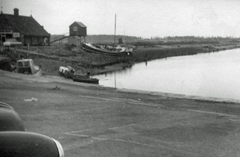 Alex and Roy launching jolly boat in Wells Harbour to take someone across to the Trinui. It wasn't me, although I did get across eventually and slept overnight on board; quite an adventure for a sixteen year old.
Alex and Roy launching jolly boat in Wells Harbour to take someone across to the Trinui. It wasn't me, although I did get across eventually and slept overnight on board; quite an adventure for a sixteen year old.
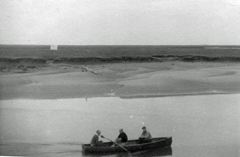 Alex rowing someone out to the Trinui. Roy is in the bow.
Alex rowing someone out to the Trinui. Roy is in the bow.
 Nearly there, with the tide on it's way in.
Nearly there, with the tide on it's way in.
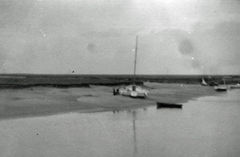 Safely ashore but with wet feet.
Safely ashore but with wet feet.
 High tide; time to come back to quayside.
High tide; time to come back to quayside.

Building of the 'Trinui'
Eastern Daily Press article dated 17 August 1962
"He intends to sail across the Atlantic and through the Panama Canal and to call at Tahiti and the Cook Islands on his way ... Mr Grimes is the second son of Mrs and the late Mr [William] Grimes. His father was in the navy in the first world war and at one time was a member of Wells lifeboat crew. His elder brother Leslie is the master of a coastal vessel (Ashleigh ex Magrix)."
"He has no previous experience of sailing but he hopes to get used to it on board the new trimaran."
"While in New Zealand he has been chief officer on a coastal ship (Maranui) and he intends to take up a similar job when he gets back there."
Copyright Eastern Daily Press (note: print layout modified for web page)

Crewmate recruited ...
Eastern Daily Press article dated 11th September 1962
"After searching for a crew and companion for a voyage to New Zealand in a trimaran, Mr Alex Grimes a 37-year-old merchant navy officer from Wells has chosen a King's Lynn seaman ... Mr Roy Garside, aged 21."
Copyright Eastern Daily Press (note: print layout modified for web page)
... and first step taken
Dereham and Fakenham Times article dated 11th September 1962
"In his search for a crew and companion on his world voyage, Mr Grimes advertised widely in yachting magazines, but the Kings Lynn seaman whom he chose called on him after reading of the proposed trip in the ‘Eastern Daily Press’."
"Quiet spoken and unassuming, bachelor Mr Grimes is very reluctant to discuss his plans and has been alarmed at the publicity his adventure has already received. "
Copyright Dereham and Fakenham Times (note: print layout modified for web page)

Grenada, Panama and next stop Tahiti
Dereham and Fakenham Times article dated 15th February 1963
The newspaper reported Trinui reached Grenada in the Windward Isles on 17th December 1962 after crossing the Atlantic.
"It was, said Alec in a letter, a terribly slow journey having been becalmed for about ten days."
"It is night time and I sit here writing to you in just my shorts, and I am still very hot. I am certainly glad I came out of England when I did by what everybody writes and tells me."
They stayed at Grenada for Christmas "... we are stuffing ourselves full of bananas, oranges and coconuts. Our fresh fruit ran out at sea. It is so hot here that to walk a mile exhausts you. The sweat pours off you all the time, so I take a couple of salt tablets every day. I cannot afford to be ill."
They left Grenada as Alex hoped on 31st December. Before leaving though, both he and Roy shaved off their beards because it was too hot to keep them.
Copyright Dereham and Fakenham Times (note: print layout modified for web page)
"... the trip from the West Indies had been perfect. The wind was astern or on the quarter, nice and steady. One day, he wrote, they did 180 miles which he considered was very good."
"At Colon, however, they hit a snag; the outboard motor packed up – and one must have a motor to go through the canal ... We borrowed an outboard from a Frenchman, Robert le Lessec, who also helped us through the Canal."
"Well, we survived the Panama Canal locks. We passed through on Friday, 25th January having left Colon at 8:15am and got through in exactly 12 hours ... It only cost me nine dollars to go through."
"... they went back to Colon by train to help le Lessec through the Canal with his 70 foot yacht. On board were two Frenchmen, two Americans, a German, a Dane, a Spaniard, le Lessec’s wife and three children!"

Last lap set-back for Wells trimaran
Dereham and Fakenham Times article dated 21st May 1963
"... a gale thrown in at the last moment when we sighted Rarotonga on May 1st ... drove us 120 miles to the north and of course we had to come all the way back again."
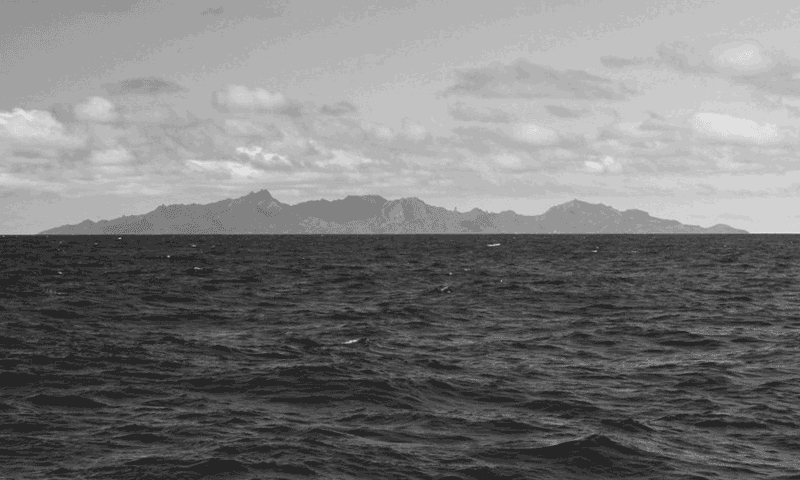
Rarotonga Island
"(then) a freak sea ... just off Rarotonga ... damaged the port float ... he says he expects to be in the Cook Islands for two or three weeks before he sets off on the last leg to Auckland."
"Pulling into Pape'ete, he was most impressed by the powered bicycles that went streaming by, ridden by Tahitian girls with long hair way down past their waists and all with flowers in their hair and wearing brightly coloured sarongs."
"He described the meals on board ... I cooked rice with dehydrated peas while Roy cooked dehydrated spuds and beans called caraotas [black beans] and garbanzo [chickpeas] beans. One tastes like butter beans, the other like hazel nuts."
Copyright Dereham and Fakenham Times (note: print layout modified for web page)
Extract from 'boatdesign.net' blog
Piver trimaran design change after the report of float damage
Though the design had been changed "after the first Piver Nimble voyage from England to New Zealand made by sailor Alex Grimes, where the problem showed up in rough seas while heavily loaded", another trimaran, Teinmouth Electron, competing in the 1968 Sunday Times Solo Race Around the World, "split her starboard float ..."
Copyright Boat Design Net

Arrival in New Zealand
Eastern Daily Press article dated 15th December 1963
"Mr Grimes' mother yesterday received a cable which told her of his safe arrival in New Zealand ... When I opened the cable and read what was on it I felt immensely relieved."
"Although I always knew he would get there I was a little worried at times as every mother would be. My only wish is that I could have been there to greet him as he came ashore."

Copyright Eastern Daily Press (note: print layout modified for web page)

Trimaran Twice Beaten Back From Coast of NZ
Auckland NZ Press article dated 21st December 1963
The newspaper reported "a yachtsman Mr A. Grimes, in his trimaran Trinui, was twice beaten back from New Zealand by southerly gales after sailing halfway round the world. On the third try he reached the New Zealand coast this week only to be becalmed."
On the first attempt, "... 200 miles north of North Cape (NZ) the Trinui ran into what Mr Grimes described as a howling gale."
"... we came down again and had another go, but southerly gales drove us back."
"The third time round they met good weather – so good that they were becalmed off Whangaroa and the harbour master, who spotted them while out fishing, towed them into port."
Copyright unascertained (note: print layout modified for web page)
Visit of Queen Elizabeth II and Duke of Edinburgh 1963
Alex arrived in Auckland the same year that Queen Elizabeth and the Duke of Edinburgh made their second visit to New Zealand and there is a Pathé News video which perhaps gives a flavour of the country at that time. Unfortunately, 'youtube' will no longer play the video within this website, so please click here to watch it in a new window.

Rough chronology of the voyage
(some dates estimated by landlubber author)
| 8th September 1962 | Trinui launched Gorleston, Yarmouth |
| 21st September 1962 | Left Wells for Fowey |
| November 1962 | Canary Islands |
| Christmas 1962 | Grenada, Windward Islands |
| February 1963 | Panama Canal |
| February 1963 | Becalmed off Galapagos Islands |
| April 1963 | Pape'ete, Tahiti |
| 1st May 1963 | Sighted Rarotonga, Cook Islands |
| 9th May 1963 | Avatiu Harbour, Cook Islands |
| June to October 1963 | Two unsuccessful attempts for NZ |
| October/November 1963 | Third attempt for NZ |
| Early December 1963 | Becalmed off Whangaroa, NZ |
| 14th December 1963 | Arrived Auckland, NZ |
Plot of course taken for voyage
(again, course estimated by landlubber author)
Google Map of the approximate course of the voyage:
and you can also click here to view in Google Maps in a new window.

Epilogue
And after completing the voyage ...
Trinui was sold soon after arriving in Auckland and Alex worked for several years back in the New Zealand merchant navy, on the Awanui and other ships, attaining the rank of Captain.
I sailed a yacht from England – So?
Otago Times (Dunedin, South Island NZ) article 14th February 1964
"To sail a yacht halfway round the world without having any previous yachting experience seems a most hazardous business to a landlubber and seaman alike"
"For the second mate of the coaster Awanui, however, yachting is just another way of getting somewhere – no matter where the destination."
The paper went on to report, “Alex says he would most certainly undertake another similar trip.He has two problems, however, money and time. But with these problems resolved Alex will probably be away sailing again”.
What Alex actually said was, as he noted on the newspaper cutting, “I would not do another trip as haven’t the time or the money”. When asked the question on a previous occasion, he had replied, "No, it was tough going and hard work”.
Copyright Otago Daily Times NZ (note: print layout modified for web page)
Alex's eventual home in New Zealand was near Kohukohu, Hokianga Harbour.
Quoting from a letter received from a close friend after his death in 1998:
"Alex acquired a small house and a couple of acres in the far north of NZ, at Kohukohu, on the Hokianga Harbour. Although a somewhat isolated spot, he walked for hours with one or other of his two dogs, over the local hills."
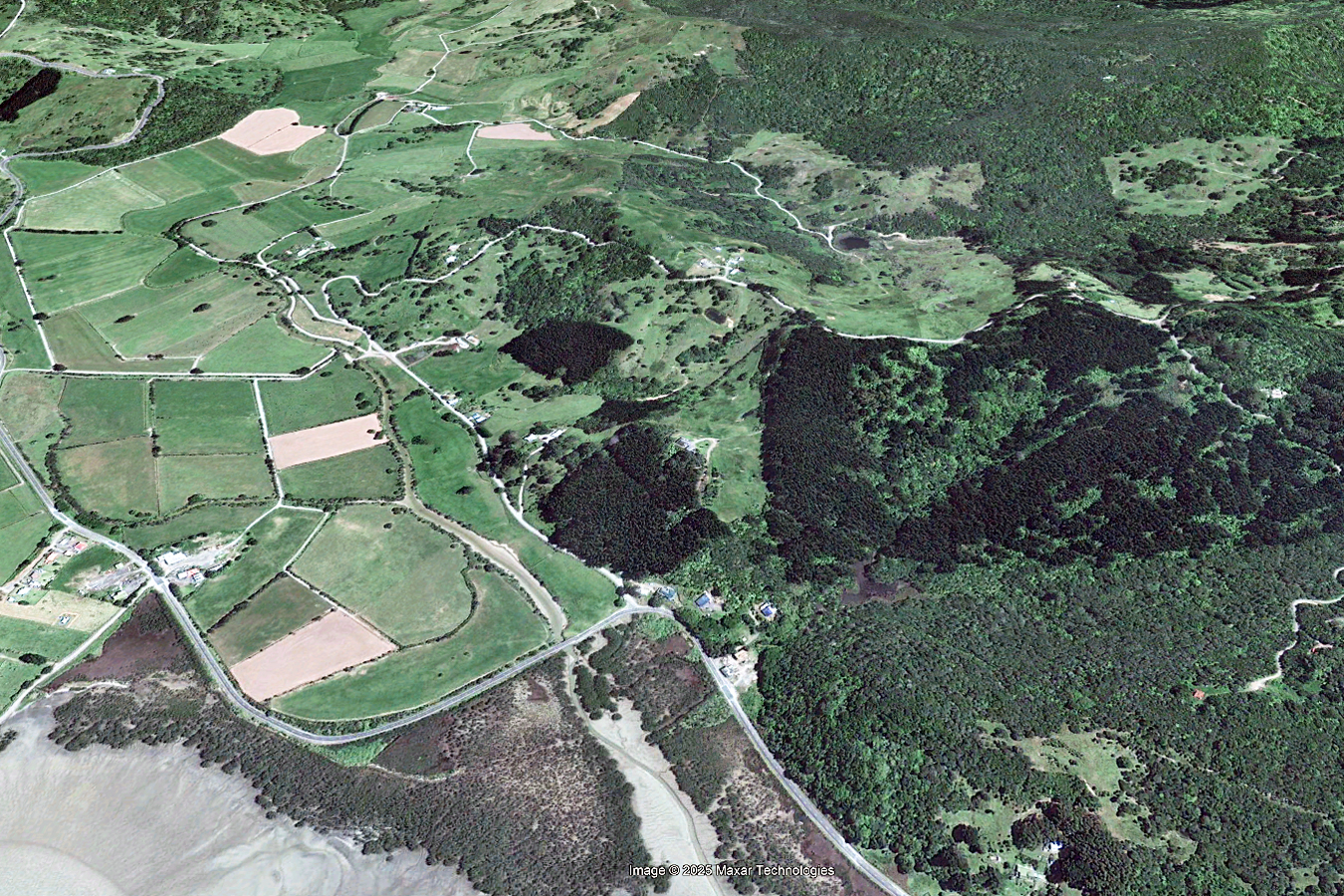
The hilly countryside around Hokianga Harbour
Sailor who completed epic voyage
Dereham & Fakenham Times article dated 30th November 1998
"A seafarer who put Norfolk on the map with an epic ocean voyage has died aged 73."
"Local historian Geoff Perkins said it became a major talking point in Wells, with people following the sea trials of the vessel. But it was a different story when the pair departed on their 11,000 mile voyage across the Atlantic and three-quarters of the Pacific ..."
Mr Perkins recalled, "They waited until conditions were right and, one afternoon, they just slipped away."
"He made arrangements that when he died, his pet dog would be put down and cremated with him and their ashes scattered over the sea together."
Copyright Dereham & Fakenham Times (note: print layout modified for web page)

Crewmate Roy Garside
Epilogue and obituary
His crewmate Roy Garside also settled in New Zealand, joining the Union Steam Ship Company and sailing for about a year as Second and Third Officer. He then changed career direction and studied surveying at Otago University, graduating as a land surveyor in 1968.
He returned to Britain and married his childhood sweetheart, Ruth, and eventually went back to New Zealand where he worked as a land surveyor firstly in Dunedin and then Christchurch. He died in 2003, aged 62, of an inoperable brain tumour.
In his obituary in the New Zealand Press, it was noted that he navigated on the voyage with just a 1924 sextant (no modern technology, such as GPS or two-way radio). He is quoted as saying about the voyage:
"At worst, it was standing waist-high in water at the helm, battling a gale and surviving on onions and custard powder. At best, it was being greeted in tropical ports by friendly people."


Notes on Piver trimarans including 'Nimble'
(copyright Pi-Craft designs)

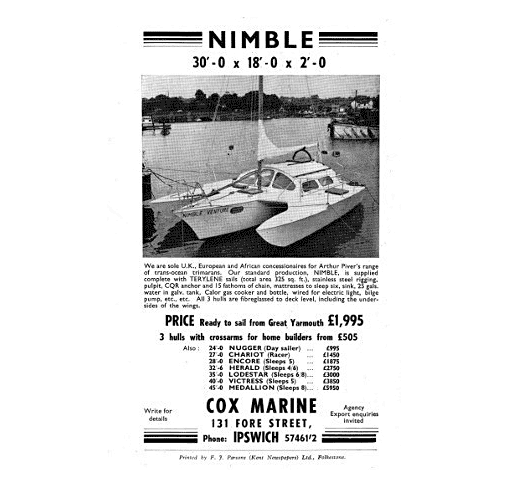
Extract from 'boatdesign.net' blog
Description of Piver Nimble construction
"The Nimble was 30 x 18 foot with a weight of 2240 lbs (optimistic), some claim 3800 lbs, and 325 square foot of working sail area. An optional 240 square foot genoa and a 650 square foot spinnaker were available. The floats had mini fins on them for lateral resistance. The draft was 2 foot with a hard chine main hull and deep V floats.
It was a plywood timber build with 9 mm plywood on the hulls, decks and bulkheads with 18 x 25 mm stringers and 19 x 65 mm chines. The forward box plywood cross beam was 450 x 225 mm. The box beam was of 9 mm plywood with 2 layers of 9mm the closer to the centre line. The aft beam was 250 x 225 mm of the same construction. Additional timber strips were added to the box beams for strength."
Copyright Boat Design Net

Extracts from Pi-Craft Trimaran catalogue 1970
Trimaran strength
Arthur Piver owner of Pi-Craft wrote in testament of his trimaran's design,
"The supreme test occurred [in 1960], which was the crossing of the Atlantic by NIMBLE. You can sail around the harbor and along the coast for a hundred years and still not know how your boat would act in a storm far at sea.
The voyage began inauspiciously, consisting of drifting around the Nantucket Lightship for several days in dead calm and pea-soup fog. Then things began to really happen. A storm arose at night - developing into ten days of continual NW gales which thoroughly tested the trimaran and its crew.
The boat was at first run off before the tempest, with a warp dragging astern according to custom, for what had been acknowledged the most dangerous situation was to go too fast down-wind for fear of broaching (an uncontrollable turn into the wind) or running clear underwater at the bottom of a wave.
Once the trailing warp twisted upon itself, apparently reducing its drag, and as the wave steepened prior to breaking, the trimaran simply surfed ahead of it, and the wave broke well astern! This was all that was needed to know, and the warp was henceforth pulled in, and the boat surfed for hour after hour, with no water on deck except for wind-driven spray from adjacent breaking waves. Then an even more exciting discovery was made - if the waves were sufficiently large NIMBLE could surf across them like a surfboard, giving even greater speed and more choice of direction."
and of its strength,
"Despite simple, unballasted construction our trimarans are proportionately stronger than any other type. Consider the case of the one which landed on a Hawaiian reef in the late Fall of 1963. For over 20 hours it was smashed against jagged coral by large seas and received only MINOR damage. No other boat - regardless of type of construction - could have withstood such a merciless beating. Again this was a display of the reduction of impulse forces by light weight."


